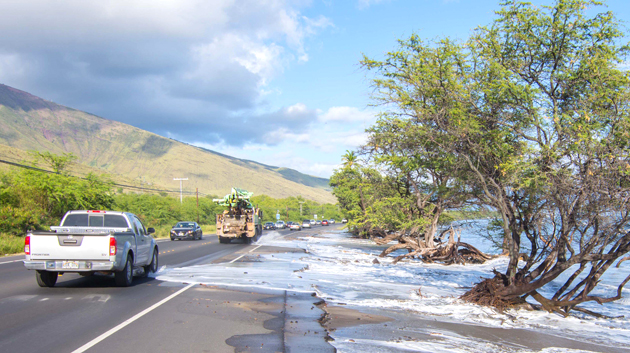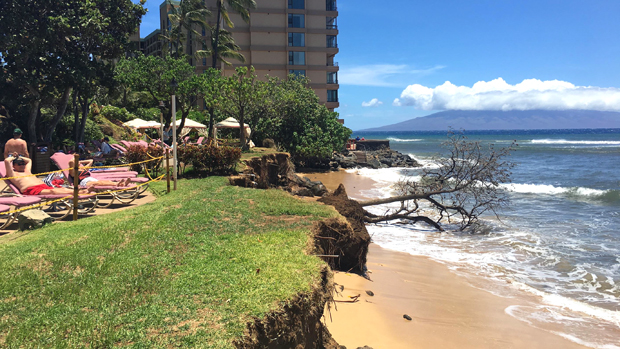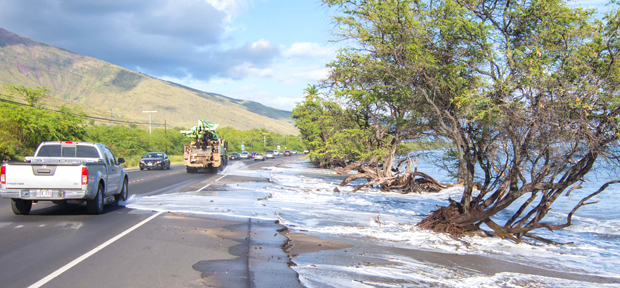

The University of Hawaiʻi at Mānoa’s Pacific Islands Ocean Observing System (PacIOOS) will develop a high-resolution, real-time wave run-up forecast and notification system for West Maui’s coastline with a $500,000 award from NOAA’s Regional Coastal Resilience Grants Program.
PacIOOS will also model a suite of inundation planning scenarios that take rising sea levels and increasing wave energies into account. Site-specific, short- and long-term forecasts, will strengthen West Maui’s coastal community and economy by enhancing preparedness and response operations, and by informing future land use planning. The three-year project is expected to begin in October 2017.
Coastal erosion, property damage and water quality concerns
A combination of high water levels and large wave swells can result in significant coastal erosion, damage to infrastructure and properties and land-based sedimentation that impairs coastal water quality. The State of Hawaiʻi has experienced an increase in wave plus tide-driven flooding in recent years, and these events are expected to grow in numbers and duration due to sea level rise and changing wave energies.

“We are affected by chronic shoreline erosion in West Maui. Some of the properties that are built close to the shoreline are literally on the brink of falling into the ocean,” said co-investigator Tara Owens, UH Sea Grant College Program coastal processes extension agent. “Flooding and wave inundation is also a major concern for our infrastructure, including Honoapiʻilani Highway, which is the only reliable access to this part of the island. These roughly 21 miles of coastline are extremely important for Maui’s economy, local businesses, homeowners and visitors, and yet they are extremely vulnerable to the impacts of rising sea levels and wave inundation.”
Co-investigator Douglas Luther, a professor with the Department of Oceanography at UH Mānoa’s School of Ocean and Earth Science and Technology (SOEST), explains, “West Maui is exposed to both large north and south swells that wrap into the coast in odd ways due to the ancient offshore reef topographies. While certain parts of the shoreline might not see any impacts, other sections can be appreciably flooded. Our model will incorporate relevant offshore and shoreline wave propagation characteristics to show the varying levels of vulnerability along the coast during each swell event.”
“We will work closely with coastal managers, emergency managers, property owners and local residents on Maui and around the state to ensure that data and tools are easy to understand and suitable for short- and long-term decision-making,” said Principal Investigator Melissa Iwamoto, PacIOOS director. “The goal is to better understand site-specific risks and vulnerabilities so that such stakeholders can integrate the information into community planning, policy-making and hazard-related ordinances.”
Data and tools will be available online
Project partners include UH SOEST, Hawaiʻi Sea Grant, State of Hawaiʻi Department of Land and Natural Resources and the County of Maui.
Citizen scientists will also participate in the project to validate and help improve the utility of the forecast through photo surveys. All data and tools will be available online for free.
NOAA’s Regional Coastal Resilience Grants Program received 167 proposals in 2017 and provides $13.8 million funding to 19 projects nationwide. NOAA, through cooperative resilience grant programs in both NOAA Fisheries and NOAA National Ocean Service, has awarded $34.7 million overall in coastal resilience grant funding from 2015 to 2017.
—By Fiona Langenberger

